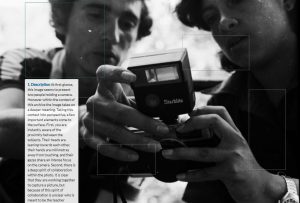DHSS Assignment Guides
Public Education-Style Image Analysis
Public Education-Style Image Analysis as a DHSS Assignment
Featuring work from Juan Pablo Pinto Mendoza‘s exhibit “Popular Education in Revolutionary Times: Reflecting on Nicaragua’s popular education program in the 1980s”

Based on Paulo Freire‘s popular education pedagogy, Popular Education-Style Image Analysis invites the student to reflect on self and society in a way that can lead to a critical consciousness and action.
Similar to, yet different from, the Historical Image Analysis approach familiar to many historians, the Popular Education-Style Image Analysis can be incorporated into Social Sciences courses as a way to connect theory to action and develop students’ digital and visual literacy skills.
Summary
Description:
- The examination of images using Paulo Freire’s popular education method
Possible tools/technologies:
- Scalar
- Omeka
- Flickr
- PowerPoint
- Prezi
Elements of Process:
- Identify photographs
- View the photograph and answer specific questions about their content and context
- Put ideas together to identify routes for possible social and/or political action based on one’s analysis
- Present the analysis
Size of assignment:
- Small to Medium
Difficulty:
- Low to Moderate
In 1968, Paulo Freire published Pedagogy of the Oppressed, a key text outlining his popular education program designed to teach illiterate Brazilian farmers how to read. Given that literacy was a requirement for voting in Brazil, teaching literacy had the possibility of significantly shifting political power and so popular education was not just about literacy but about significantly transforming the world.
Based on Freire’s work, Professor Emerita Deborah Barndt from York University worked in Nicaragua’s Adult/Popular Education program in the 1980s. In 2017, she donated many of her papers to York’s Centre for Research on Latin America and the Caribbean (CERLAC) for digitization. Project member Juan Pablo Pinto Mendoza worked with her on developing an online archive, which holds papers and photographs from this time.
In the process of working with these materials and learning about Popular Education, Juan Pablo wanted to bring a Popular Education analysis to his exhibit. He drew on Dr. Barndt’s experience with Popular Education to develop an image analysis method he applied to multiple photographs.
Juan Pablo’s analysis involved asking one’s self about:

- Description: What did you see, hear, or feel in their stories? What do you think is happening? Tell how you feel about it?
- Personal Association: Have you ever had an experience like that? Can you identify with the problem presented?
- Social Relationship: How is your experience similar to the experience of others? How is it different? Do you see problems that other people also have?
- Analysis: Why does this problem exist? What happens because of it? How does it relate to other problems?
- Action: What resources (person, group, or community) could help solve this problem in the short and/or the long run?
Juan Pablo then engaged in the analysis of one photograph from Dr. Barndt’s collection. This style of analysis allowed for a deeper, more personal, and more political exploration of the image and the context of its creation and (re)presentation.
In the Assignment Guide for Historical Image Analysis, I identified that you can find image analysis worksheets online from several sources. However, “Popular Education” Image Analysis invites the viewer to reflect on self and society in a way that can lead to a critical consciousness and action in ways that standard Historical Image Analysis does not.
I also identified in the Assignment Guide for Historical Image Analysis that one of the strengths of engaging in historical photo analysis with DHSS is that many of the images were not created digitally and thus having the digital historical images available to us on a laptop, phone, or tablet, available to be “remixed” and creatively transformed, is where the meaning making potential lays.
Juan Pablo’s analysis from a public education point of view, as well as a view from a filmmaker, highlights personal reflection, as well as the development of digital literacy by looking at images’ visual rhetoric. To explore this more, I recommend Purdue Online Writing Lab (OWL)’s Visual Rhetoric PowerPoint video created by Karl Stolley and Allen Brizee (a PPT file will download and open), as well as this Visual Analysis slide deck developed from the composition textbook Frames of Mind.
The presentation of Juan Pablo’s Popular Education analysis, like Denise’s “pop-up” historical image analysis, was done through Scalar. To replicate their work, one would have to be familiar with Scalar, but an alternative to this is to use a platform like WordPress or a photosharing site like Flickr. that students may be more familiar with There are surprisingly not as many photo analysis tools for DHSS as one would think. Thus, to show students’ analyses, you can be creative in the tools your students already know, such as PowerPoint or Prezi, as well as integrate their formal analysis into other assignments, such as developing an exhibit, creating metadata, mapping, or proving/disproving an argument.
Images can be chosen from archived sources but also collections of unidentified photos that can be found on Instagram, Flickr, and other photosharing sites. In many ways, asking your students to analyze less-common photographs than the ones used in class may elicit more complicated ways into content analysis.
Public Education-Style Photo Analysis suggestions
Images can be chosen from archived photographs, but engaging in this work with common or familiar media such as advertisements, Instagram posts, or memes may encourage greater critical analysis of the images that make up students’ worlds.

